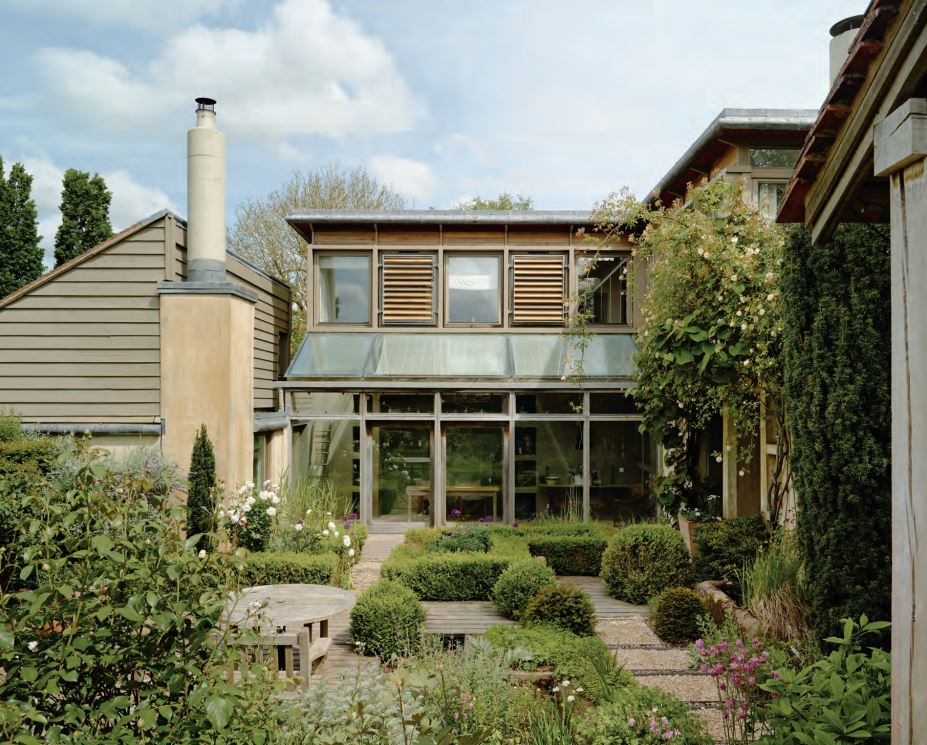Individual House
Hollick & Bucknall House by Proctor & Matthews Architects
Hollick & Bucknall in Buckinghamshire was presented at the AT Awards live finals on 18 September 2024. Learn about how the project has stood the test of time.
Intended for three generations of the Hollick/Bucknall family, the two houses are situated within the grounds of Manor Farm, adjacent to the village green, pond and medieval church of Haddenham in Buckinghamshire. Designed by Proctor & Matthews Architects, the dwellings not only respond to the geometry of the farmyard grouping and its relationship with the surrounding countryside, but also to the family’s preoccupation with farming, horticulture and landscape design.
The adaptation and repurposing of an existing farm building to form Bucknall House is combined with the addition of new-build Hollick House in both plan and form to extend the network of farmyard spaces. Conceived as ‘external landscaped rooms’, a pair of courtyard gardens connect the new and old structures, while a ha-ha on the open western boundary delineates the farmyard cluster from a bucolic pasture beyond.
In the new dwelling, a ‘garden wall’ organises both the internal and external space, providing support for the stairs, conservatory, library, a fireplace and snug, as well as linking the spatial geometry of the house with the topography of the farmland. The converted barn walls, made from Oxfordshire stone and local mud-based wychert, have been carefully restored, while timber posts and trusses stabilise and organise the new living areas.
Stephen Proctor and Andrew Matthews of Proctor & Matthews Architects talk to their client David Hollick about the influence of Peter Aldington and the way Hollick & Bucknall House has become embedded in its landscape over time
Stephen Proctor The project was designed for three generations of the same family. The client, David Hollick, and his wife Caroline and their two children lived (and still live) in one house, while Caroline’s mother and father lived in the other. The houses are located within a few minutes’ walk of Peter Aldington’s house at Turn End (AT331). Peter has been a great influence on us as architects; he taught us at university and we’ve stayed in touch since. He was also instrumental in helping David and Caroline to find an architect for their two houses. The interesting thing about Turn End is the relationship between the house’s internal spaces and the external spaces of the gardens that surround it. David and Caroline are both involved in horticulture, and David, who is a wonderful constructor and designer of gardens, has worked with Peter over the years. So we knew that this relationship between garden and home was very important. Haddenham is a village of walls, so our idea was a composition of garden walls overlaid with the two dwellings: the conversion of an existing farm building and a new house.
Andrew Matthews The configuration of the new and the existing dwelling, their relationship to one another, and their relationship to the open meadowland, was a critical design driver. David and Caroline’s house wraps around a U-shaped plan to capture a courtyard at the centre of the assemblage, and with garden walls to capture other landscaped spaces. Just as the site plan is organised by wall structures, so too is Hollick house organised by a wall. This links around the kitchen – where there are deep recesses for things like herbs on one side and plants on the other – before wrapping around to organise the conservatory, where on one side there’s a big plant wall to bring in those tender plants in the winter. Eventually it turns into the living room and captures a seat looking back across the water trough, and at the very end it captures a fireplace.
Stephen Proctor It was really important that the buildings, sitting now on the lower ground towards the meadow, became subservient in their massing to the existing larger-scale barn. The buildings have, over time, become embedded in this amazing landscape.
The ‘garden wall’ gives filtered views of the courtyard and provides shelves that mirror the external shelving for plants
Andrew Matthews Plant shelving in the conservatory blurs this idea about where the landscape moves into the house. A loggia structure that was originally planned, but built slightly later, helps to enclose the courtyard even more, and provides an external room for barbecues and outside dining. I think what’s important is that wherever you are in the house you’re connected to the garden or the landscape beyond, and the views you get of the landscape are filtered through objects and shelves. And as you climb up to the gallery on the first floor, you get those distant views of the landscape beyond. Our work finished in the late 90s, which is when David and Caroline’s work really began. Now, as you walk round the house, those landscape rooms they envisaged in their minds all those years ago have really taken shape. It’s interesting to hear David talk about the way the house supported his family as it grew and evolved.
David Hollick When our teenage children had friends around, they used to occupy the kitchen and then we’d transport ourselves to the living room, where you were far enough away not to be too disturbed, but could also look back and keep an eye on them!
Andrew Matthews And that’s something a modern family house with open-plan kitchen/living/dining can’t offer. So the organisation of the house did offer a place to escape, didn’t it really? For all of you?
A pool and running water bring a zen-like quality to the courtyard of Hollick House. The plant shelves are part of a continous ‘garden wall’ that organises the internal and external space.
Stephen Proctor Bucknall House is a converted farm building, and we made the simple gesture of creating a new framework within the existing walls. This allowed us to lift the roof and add an additional floor without loading the historic walls with more weight. We put in new footings to hold up the frame.
Andrew Matthews The frame actually helped stabilise the existing walls, which were repaired and repointed with lime mortar. And then there’s the glass clerestorey, which is structural and actually locks the two structures together.
Stephen Proctor There were no new openings made, just insertions into the existing framework.
Andrew Matthews These are contemporary windows, but they reference the way agricultural buildings around this locality work.
Stephen Proctor One of the key challenges at the early stage of the project was considerable opposition from the planning authority. This was seen as a very sensitive site as it falls within a conservation area, and the idea of adding new buildings was rejected by the planning and conservation teams. But, with help from David and Peter Aldington, we consulted the local residents, and I think ultimately they were quite horrified that there was an attitude of no change within the village. They saw it as being pickled in aspic if you like. So at the planning committee meeting there was a lot of support for the project and the recommendation for refusal was overturned.
Andrew Matthews David and Caroline have evolved this amazing garden around the house. And I have to say that in a lifetime of being an architect, it’s very rare that you get a client that continues to evolve a garden envisaged all those years ago. The house has also evolved and there are always ideas about how the family could live and extend; a way of life with the garden. And so in that way it has been quite flexible I think.
David Hollick Yes, very much so. I’ve had very few problems with the house, apart from decoration and a few timber boards to replace. So overall it’s definitely stood the test of time.
Other finalists in this category:

Dundon Passivhaus by Prewett Bizley Architects

Islington Courtyard House, by Miltiadou Cook Mitzman Architects
Our awards sponsors














